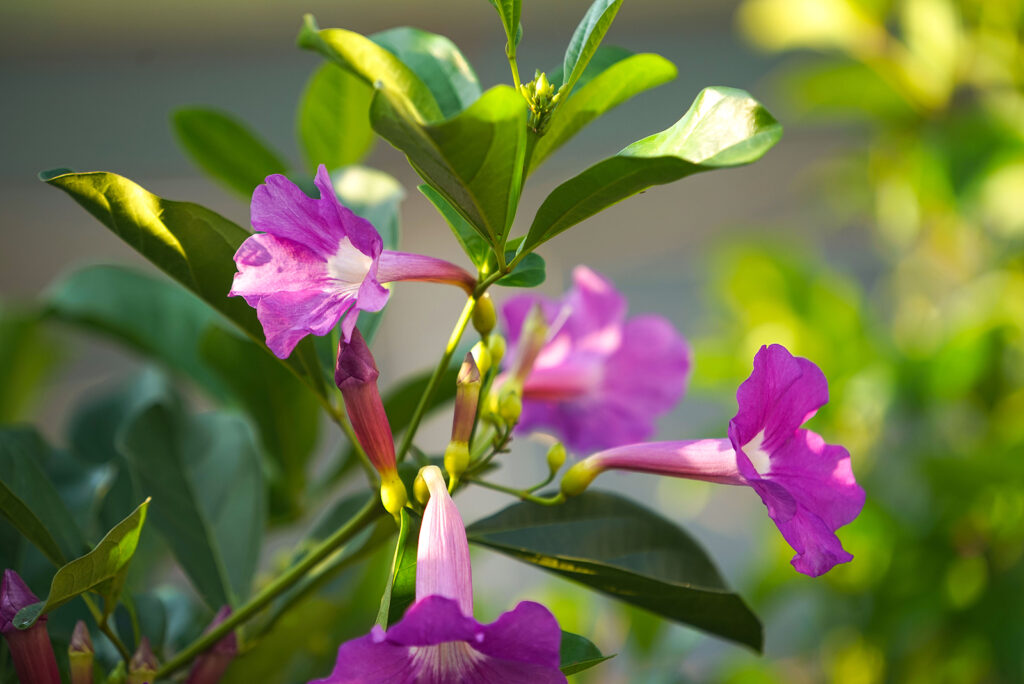Bignonia — commonly called cross vine–is an evergreen climber grown for its cymes of 2 to 5 trumpet-shaped flowers. Bignonia is a vigorous climber that can grow to 10 feet (3m) or more in a season.
Bignonia is a good choice to train on a wall, trellis, or over a pergola. The shiny dark green leaves consist of 2 to 6 inches leaflets and a branching tendril. In winter leaves can turn purple or in severe winter weather fall off.
Bignonia is a genus of just one species. The Bignonia family (Bignoniaceae) includes several well-known vines that were once classed in other genera or families; they include B. cherere (see Distictis buccinatoria), B. chinensis (see Campsis grandiflora), B. jasminoides (see Pandorea jasminoides), B. radicans (see Campsis radicans), B. speciosa and B. violacea (see Clytostoma callistegioides), B. tweediana (see Macfadyena unguis-cati), and B. venusta (see Pyrostegia venusta).

Get to know Bignonia
- Plant type: Evergreen climber, vine
- Growing zones and range: Zones 6 to 9
- Hardiness: Hardy to Zone 6
- Height and width: Height depends on structure
- Growth rate: Fast; 10-30 feet (3-10m)
- Form and habit: Climber
- Foliage: Shiny, dark green leaves consist of two 2-6 inch (5.1-15.2cm) that turn reddish purple in the South, but in colder climates tend to brown by the end of winter; leaf cover is not dense
- Flowers: Clustered, 2 inch (5.1cm), trumpet-shaped, fragrant red-orange flowers
- Bloom time: Spring into summer
- Uses: Against brick or tan walls, covering fences, poles, masonry walls, and outbuildings, or as ground cover
- Garden companions: Other spring bloomers
- Common name: Cross vine
- Botanical name: Bignonia
- Family name: Bignoniaceae
- Origin: South and lower Midwest
Where to plant Bignonia
- Plant Bignonia in full shade to shade; tolerates heavy shade, but blooms best in full sun.
- Plant Bignonia in soil with plenty of organic matter.
- Protect Bignonia leaves from winter winds.
When to plant Bignonia
- Set Bignonia in the garden in spring.

Planting and spacing Bignonia
- Space Bignonia 10 to 30 feet (10m) apart.
- Sow seed in spring. Layer existing plants in autumn or spring.
How to water and feed Bignonia
- Give Bignonia regular water.
- Allow Bignonia to dry down.
- Feed Bignonia with an all-purpose organic fertilizer in spring.
How to care for Bignonia
- Train Bignonia on a sturdy arbor to shade your garden; its tendrils wrap around other plants, and onto netting and chain link.
- Prune Bignonia to control its size and to protect structures.
Bignonia pests and diseases
- Bignonia is rarely troubled by pests.
Bignonia propagation
- Propagate Bignonia by layering stems in spring or fall or by cuttings in summer.
- Start seed indoors in spring.
Bignonia varieties to grow
- Bignonia capreolata, Cross vine, this climbing vine ranges from 30-60 feet (9.1-18.3m) and bears lance-shaped leaves to 7 inches (17.8cm). Clusters of fragrant, 2 inch (5.1cm) long trumpet-shaped flowers appear in spring. Blooms are red-brown outside and yellow-orange inside. Zones 6 to 9.
- ‘Astrosanguinea’ has reddish-purple flowers.
- ‘Jekyll’ bears flowers that are orange on the outside and yellow inside, but not fragrant.
- ‘Tangerine Beauty’ is clear orange and exceptionally bright colored and free blooming, but also not fragrant.















